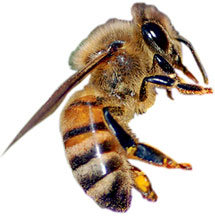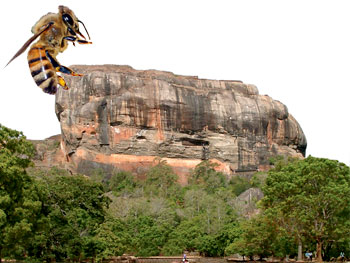 Bee alert! Bee alert!
The sting may not be deadly, but best let them be:
by Umangi de Mel
Been stung lately? Nope, not by (venomous) colleagues but by the ones
who came into the limelight faster than anybody could say `BEES'!? The
giant honey bee, a very low profile insect has been creating headlines
in the media quite often during the past couple of months.
The locals believe that they are king Kashyapa's soldiers reborn as
warrior bees, 'stinging' the day lights out of its noisy and unruly
visitors, just to keep the rock clean and quiet.
About 160km away from Colombo, the lion rock stands tall and strong,
sheltering its historical treasures that won Sri Lanka a conspicuous
place in the world. The Kingpin behind the concept is Kashyapa who is
said to have killed his father and sought protection from an enraged
brother.
Fifteen centuries ago, the majestic rock was his kingdom with its
many marvels. King Kashyapa, a man of earthly pleasures had both
concubines and soldiers attending to his every need.
And the rock did protect him for 18 years, till he took his own life
when he was finally attacked by the brother. But the frescoes, the
mirror wall and the pools remain, as a very aggressive 'bee' army keeps
them safe.
|

Remains of Kashyapa’s castle, guarded by a ‘bee’ army |
The giant stinging honey bees also known as `Apis dorsata' are a most
aggressive and deadly type of bees found in South Asia. Seen all over
Sri Lanka the giant honey bee is larger than the ordinary honey bee and
its stinger is three times as long.
They are very defensive and act as one battalion when under attack
and give up their lives for the sheer survival of the queen who is the
only fertile female in a colony whose main task is to lay eggs.
"When all species of honeybees share a common foraging area, the
honey bee will be the first to leave that area for a new one once the
environmental conditions become harsh and competition for food becomes
evident," says Dr. R.W.K. Punchihewa Entomologist, University of Ruhuna.
The rainfall patterns too determine the migratory patterns of the
bees. They fly away from the rain towards other sources of food.
This type of honey bees build their nests in open areas like tree
branches and rock crevices where they can see the sun, using it in
navigation to find food.
Sigiriya is one of the main nesting sites for the bees on their
migratory path. They could have been coming to Sigiriya for thousands of
years and the bees are an essential characteristic of the rock", says
the entomologist.
Everyday, the grand citadel is visited by hundreds of thousands of
local and international visitors, who undoubtedly find it magnificent.
"There are 17 honey bee nests at Sigiriya when the crowds get louder
and unruly the bees become restless. It could be even the increasing
heat that's making them aggressive.
Some school children have thrown things which accidently hit the
nests and the bees went on a rampage, all of a sudden.
The nests are found mainly between the summit and the Lion's paw
where most of the accidents happened during the past few months. About
500 people climb the flight of stairs at once and it's very difficult to
protect all of them at once during an attack. We have about 70
protective suits and two protective cages which can hold about 75
people.
|

King Kashyapa’s soldiers? |
The bees are attracted to noise. I hope the nests will be removed
soon as I feel that human lives are more important. The Wild Life
Department should take necessary steps. Otherwise tourism will go into
decline." Says Sumedha Karunaratne, Project Manager of the Cultural
Triangle, commenting on the issue.
When under attack, the bees form their 'bee blanket'. They cling
together to form a defensive curtain and the size of the nest expands,
after which even the slightest wind can provoke them.
When they 'smell a rat,' they warn the predator with a 'hiss' not to
get closer. The sound is produced using a rhythmic body movement and the
waves ripple across the colony raising the alarm. "The bees don't
normally attack even if you go near a nest.
But they grow restless with vibrations of the crowd. The moment you
crush a bee, a chemical signal called a 'pheromone' is sent to the nest.
If you crush more bees, then more alarms are generated, which cause an
immediate violent reaction in the colony and the bees rush to the source
of the alarm as they think that the colony's under attack.
Always attacking downwards for several hundred metres, once the giant
stinging bees are on the attack, they're merciless and attack anything
that moves," says Dr. Punchihewa.
When a bee stings once, the stinger, poison sac and several other
internal organs are torn from the bee's body. The bee dies instantly but
the stinger should be removed immediately from the victim's skin as the
reflex of the muscles allow it to go deeper.
The discharge of toxin increases the pain. Complications may result
from the stinger being embedded in the skin for which reason, the entire
stinger should be removed fast. "The condition of a victim depends on
the amount of venom that's entered into his or her system.
The bee venom contains histamine, dopamine phospholitase A2, and
toxic peptides which could be deadly if you don't manage the shock. If
the acute stage is managed immediately, there won't be any
complications.
Symptoms occur depending on the person. It's mainly an allergic
reaction that results in itching and pain and some show symptoms such as
swelling, nausea, abdominal pain, swelling in the larynges that causes
difficulty in breathing called the Anaphylactic shock.
"It's a common occurrence in this area although it has increased this
year, probably due to the big crowds. About 15 villagers come for
treatment per month. It's not a big issue actually. Bees have always
been here and since it's a sanctuary, the bees can't be killed either.
Best thing is to raise awareness, be calm and not provoke the bees
when visiting the Sigiriya rock," says Ruwan Subasinghe, medical officer
in charge of the Sigiriya hospital.
However, there's been no fatalities from bee attacks in Sigiriya.
After the monsoon rains in October, the warrior bees leave Sigiriya and
find new nesting grounds. Although the colony loses up to 50% of its
bees in the process, the youngsters somehow find their way back to
Sigiriya in January the following year.
"We can't put an electric fence for bees and keep them out like the
elephants. This issue has been there since my childhood. We haven't got
any requests from the Central Cultural Fund (CCF) so far. We'll send the
experts to attend to the problem," says W.A.D.A. Wijesooriya, Director
General of the Wild Life Department commenting on the issue.
"True we haven't written officially but the Wild Life Department
doesn't need a request to take action. It belongs to the wild life zone.
"Anyway the Ministry of Agriculture is working on a long term plan
for next year," says A.M.J. Perera, Additional Director General of the
CCF.
The giant honey bees are an integral part of the Lion rock. Without
the bees, Sigiriya will lose its character, "People need to be educated.
Obviously there have been a lot of disturbances which is probably why
the attacks have been more frequent. It's very unusual though.
There's no easy way out, you've got to manage the environment in such
a way that the bees get attracted to another amicable place. Killing
them is hardly the solution as they pollinate a major number of plants
from Horton Plains upto the sea," states Dr. Punchihewa.
[email protected] |
